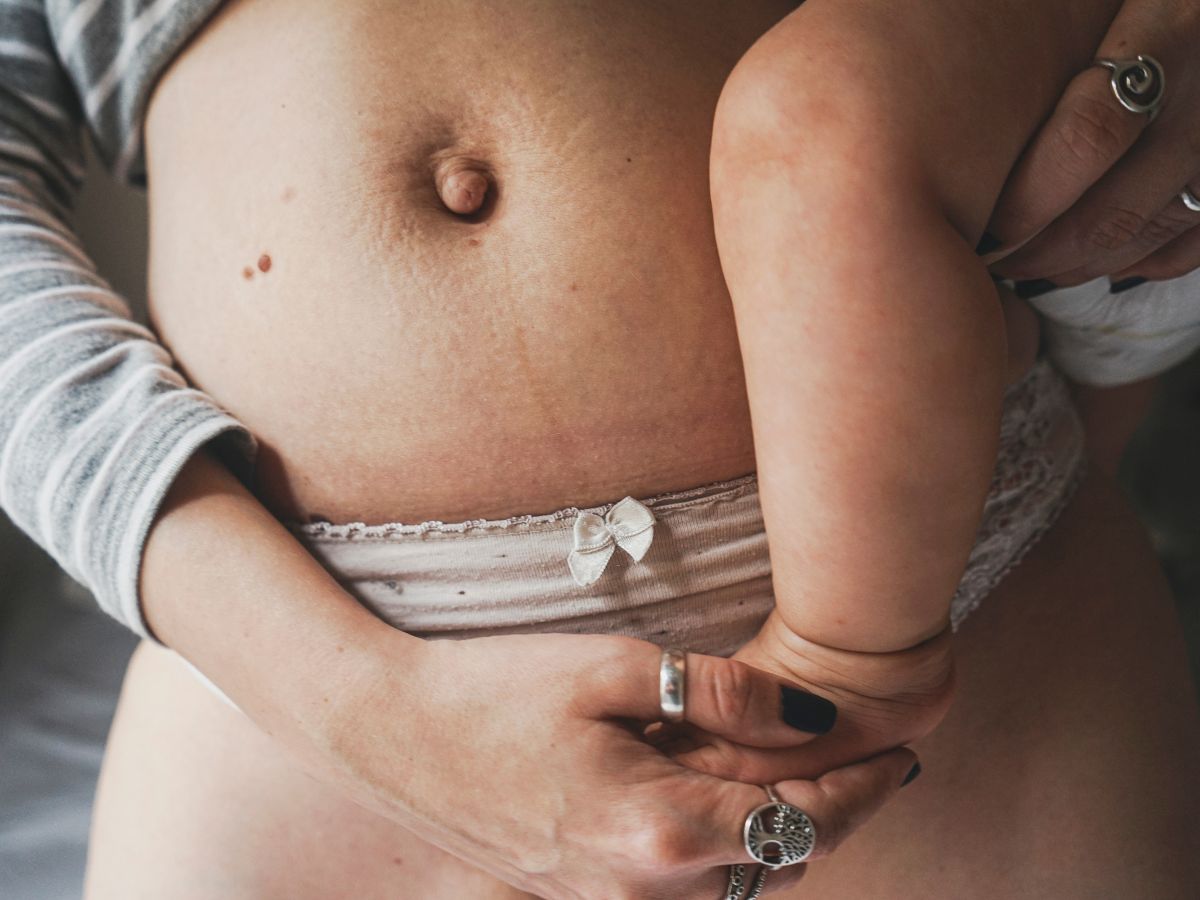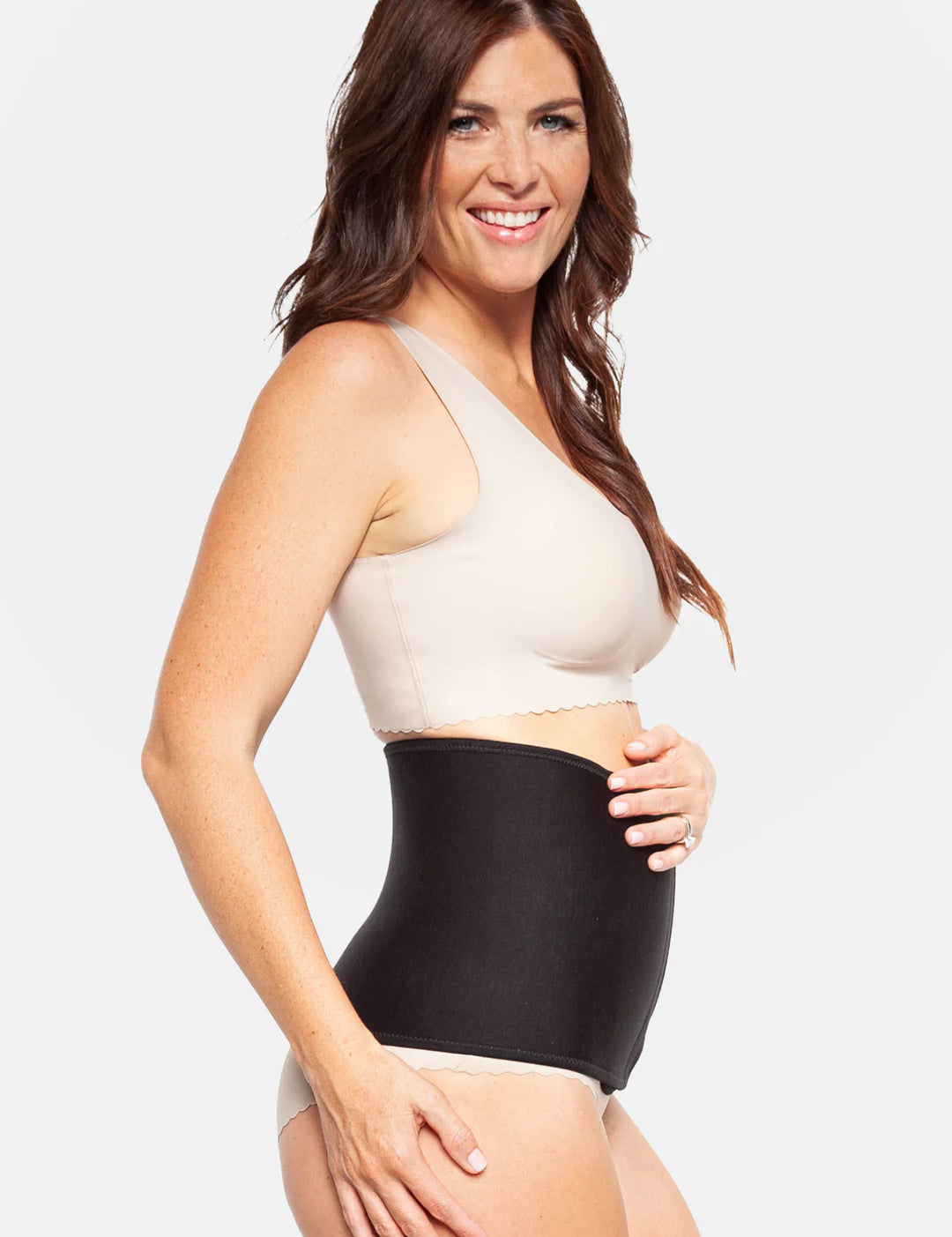Becoming a mom is a journey filled with joy, challenges, and changes, especially to your body. If you're grappling with a c-section pouch, and are in the thick of postpartum recovery while breastfeeding, know that you're not alone. The c-section pooch is a common concern, but we've got some reassuring news: there are gentle, effective ways to heal and regain confidence in your body.
Understanding Your Post-C-Section Body
After the miracle of birth through cesarean section, your body has undergone significant changes. The c-section pouch, sometimes referred to as the 'c-section shelf', is often the result of a combination of factors such as loose skin, stubborn fat deposits, and changes in your abdominal muscles. But why does this happen?
Abdominal Muscles and Connective Tissue
During pregnancy, your growing baby puts pressure on your abdominal wall, which can lead to a condition called diastasis recti – a separation of the abdominal muscles. The c-section procedure adds to this by cutting through these muscles and surrounding tissue, leading to potential scar tissue and a hanging belly.
Skin and Fat Changes
The stretching of your skin to accommodate your little one can leave you with excess skin post-delivery. Subcutaneous fat, which is just below your skin, can also change during pregnancy and become more stubborn to shift, especially around the lower abdomen.
Nurturing Steps to Recovery

1. Embrace a Balanced Diet and Regular Exercise
The most important thing for new mums is to focus on a healthy lifestyle. Incorporating a balanced diet and regular exercise into your daily routine can help manage weight gain and promote a flat stomach. Core muscle exercises, particularly those that strengthen the pelvic floor muscles, are beneficial. Some beneficial exercises can be pilates or mat pilates that focus on strengthening the pelvic floor. Make sure to speak with your doctor about the appropriate time to start exercising.
2. Consult Healthcare and Fitness Professionals
Before embarking on any treatment plan, it's crucial to consult with your healthcare provider and possibly a physical therapist or personal trainer who specializes in postpartum recovery. They can guide you through an exercise routine tailored to target the c-section area, ensuring your healing process is on the right track.
3. Consider Non-Invasive Treatments
If you're looking for cosmetic improvements, there are non-surgical options like scar mobilization, c-section scar massage, and treatments to improve the appearance of your c-section scar and skin texture. These can be effective ways to reduce the c-section pouch without major surgery.
4. Plastic Surgery
Plastic surgery, like a full tummy tuck surgery or a mummy makeover, is a more drastic option and should only be considered after you've tried other methods and discussed with a plastic surgeon during a free consultation. Remember, any surgical intervention comes with its recovery time and risks. Please these procedures can be very costly.
5. Celebrate the Small Wins
Every mom's postpartum body is unique, and healing takes time. Celebrate the small victories, like the gradual return to normal activities, improvement in lower back pain, and even minor changes in the appearance of your belly. Your journey is personal, and each step forward is a triumph.
6. Support and Community
Connecting with other new mums can be incredibly uplifting. Share tips, experiences, and maybe even regular exercise sessions. Remember, the best results often come from a combination of support, knowledge, and patience.
Proactive Measures to Prevent Postpartum "Pooch"
The journey to motherhood is an intricate tapestry woven with anticipation, transformations, and, yes, a few challenges—like the potential emergence of a postpartum "pooch". But, the good news is that there are preventative strategies you can adopt even before your cesarean delivery to help maintain the integrity of your abdominal area and minimize the chances of developing a c-section pouch.
1. Maintain a Healthy Diet
One of the best ways to prevent excess body fat and the associated postpartum pooch is by sticking to a healthy diet throughout your pregnancy. Nutritious foods fuel your body and baby while helping to regulate blood flow and reduce the storage of fatty tissue.
2. Focus on Core Strength
Building your core muscles is a treatment option that can serve you well. With the guidance of a professional, engage in safe exercises to enhance the strength of your stomach muscles. This muscle repair strategy helps maintain the abdominal skin's elasticity and firmness, possibly mitigating the amount of extra skin post-delivery.
3. Consider Support Garments
A belly band can be a great way to provide support during and after pregnancy. By promoting proper posture and reducing strain, it helps in the overall muscle repair process.
4. Plan Ahead with Your Healthcare Team
If you know you will have a cesarean birth, discuss all your treatment options with your healthcare provider. This might include cosmetic procedures post-delivery that enhance scar appearance and support skin elasticity. It's never too early to consider how to best care for your c-section scar.
5. Understand the Importance of Post-Delivery Care
Postpartum recovery is the main reason to have a well-thought-out plan for after your baby arrives. This includes understanding the right time to resume gentle exercise to encourage weight loss and improve the condition of your abdominal area, always ensuring any exercise is approved by your healthcare provider.
6. Embrace a Balanced Approach
While cosmetic surgery, like a tummy tuck procedure, is often sought out for quick fixes, it's not the only way to address a postpartum belly. In fact, combining a balanced approach of diet, exercise, and possibly non-invasive cosmetic procedures is typically the most effective way to prevent and treat a postpartum pooch.

Hydration: The Unsung Hero in Reducing Postpartum "Pooch"
Amid the wealth of advice on how to reduce a postpartum "pooch," one fundamental aspect of well-being that deserves a spotlight is hydration. For moms focusing on recovery and rejuvenation following a c-section delivery, understanding the role of water in the body's healing process is vital.
Vital for Healing
Post-cesarean birth, the body enters a state of repair, and hydration plays a key role in this healing process. Water is essential for maintaining healthy blood flow, which is crucial for delivering nutrients to the incision site and throughout the abdominal area, supporting the body's natural healing mechanisms.
Enhances Metabolism
Staying well-hydrated is also integral to boosting metabolism, which can aid in the more efficient burning of excess body fat. Water helps to metabolize fat cells, potentially reducing the fatty tissue that contributes to the postpartum belly.
Improves Skin Elasticity
Water is the body's natural moisturizer, improving the elasticity of abdominal skin, which can help to minimize the appearance of stretch marks and extra skin. For moms considering cosmetic procedures or a tummy tuck procedure to reduce their "pooch," optimal hydration can complement the recovery and outcome by maintaining skin pliability.

Supports Digestion and Reduces Bloating
Adequate fluid intake supports digestion, helping to reduce bloating and discomfort in the stomach muscles, which can accentuate the appearance of a "pooch." By ensuring that the digestive system is functioning smoothly, you're also promoting a flatter stomach.
Facilitates Weight Loss
When it comes to weight loss, drinking enough water can be an effective way to help manage hunger and decrease caloric intake. Often, our bodies can mistake thirst for hunger, leading to increased eating when actually, a glass of water is what's needed.
Key for Breastfeeding Moms
For breastfeeding moms, hydration becomes even more critical. Breast milk is composed of about 90% water, so maintaining good hydration can ensure an ample milk supply.
How to Stay Hydrated
To ensure you're getting enough water, aim for at least 8-10 glasses a day, and more if you're breastfeeding. Keeping a water bottle handy throughout the day as a reminder to drink, consuming fruits and vegetables with high water content, and drinking fluids at every meal can help you meet your hydration goals.
In the journey to reclaim your body confidence postpartum, don't underestimate the power of hydration. It's a simple, yet profound step in your daily routine that can amplify your efforts in reducing the "pooch" and support your overall health as a new mom.

EasyJug: Simplifying Hydration for C-Section Moms
After a c-section, as a new mom, you're navigating the healing process, managing your postpartum belly, and adjusting to the demands of breastfeeding. Your body needs more water than ever, but between nursing and recovering from major surgery like a c-section, getting enough to drink can be surprisingly challenging. Enter EasyJug, a hands-free water bottle designed specifically with breastfeeding moms in mind.
Designed for Comfort and Convenience
EasyJug is a large water bottle equipped with a 47 inch long, flexible straw, allowing you to drink comfortably in any position—even while lying down next to your baby. This design is perfect for new moms who have had a cesarean delivery and might find it uncomfortable to move or sit up to drink.
Promotes Hydration for Breastfeeding
Staying adequately hydrated is essential for maintaining a good milk supply, as breastmilk is made up of a large percentage of water. EasyJug holds up to 2.2 liters of water, which is about 9 cups, making it easier to meet your hydration needs without constant refills.
Hands-Free Use
With the EasyJug, you don't need to hold a water bottle. It's designed to provide you with the ability to drink effortlessly while your hands are full—holding your baby, for instance. This is especially valuable for moms who are also dealing with incision recovery post-cesarean birth, ensuring that your scar healing remain uninterrupted by the need to reach for a drink.
Supports Postpartum Recovery
Proper hydration is critical for recovery from any surgical procedure, including a c-section. It helps reduce excess body fat, improves blood flow, and can also help the body heal faster. The EasyJug supports this by making it simple for moms to get the water they need to help reduce their "pooch."

You're More Than a "Pooch"
Dear moms, your value isn't measured by the firmness of your belly or the bikini you rock. It's in the late-night feeds, the soothing lullabies, and the unending love you give. Your c-section pouch is a badge of this love, and we're here to support you as you find the best course of action for you and your body.
Remember, while this journey may include challenges, the goal isn't just a cosmetic one; it's about your overall well-being and the joyful life you'll lead with your new little one. With the right approach and plenty of self-love, you'll be on your way to feeling like your best self, inside and out.
Community & Support
We know the beautiful chaos of motherhood – the endless feedings, diaper changes, and sleepless nights. Amidst all this love and care, it's easy to forget about your own well-being. That's where EasyJug steps in – to make hydration a breeze for you.
Join our community of nurturing mothers and prioritize your health with EasyJug. Sign up now to receive exclusive tips on staying hydrated during your breastfeeding journey, along with special offers just for you.
Because when you take care of yourself, you can give your little one the best version of you. Let's hydrate together and thrive as moms!
Sign up today and get 10% off your first purchase!




